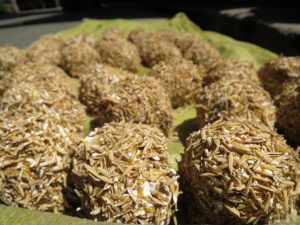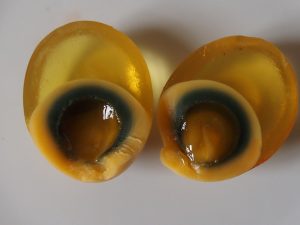变蛋
Bian Dan
Transformation Eggs

Transformation Eggs [bian dan 变蛋] are a type of preserved eggs, notorious and originating in Henan province, China. Despite being consumed widely and often on a weekly basis by all strata of society in the Middle Kingdom, it is also considered one of the most effective medicines for heartburn due to his alkaline nature, thus counter-acting the overproduction of stomach acids and acid reflux. It is relatively easy to make, cheap and once Westerners overcome their initial hesitancy, equally enjoyed. It is also known under a variety of alternative names such as Amber Eggs [hu po dan琥珀蛋] , Diamond Eggs [zuan shi dan钻石蛋], Pine Flower Eggs [song hua dan松花蛋] and Crystal Eggs [shui jing dan 水晶蛋].
Ingredients
12 large free range eggs
250g Calcium Oxide [CaO], commonly known as Quick Lime or Burnt Lime [sheng shi hui
生石灰]
50g Sodium Carbonate [Na2CO3][jian fen 碱分] or alternatively potash or grass ash [cao mu
hui 草木灰] [K2CO3]
Water or Black Tea [appropriate amount]
Saw Dust or Rice Husks [appropriate amount]
Equipment
Chemical resistant gloves
Eye protection [due to the corrosive nature of caustic lime or slaked lime]
Dust mask
Glass mixing container
Stirrer
Vacuum seal bag/Plastic sealable bag/Airtight container
Small bowl
IMPORTANT INFORMATION
• When calcium oxide combines with water it creates a powerful exothermic reaction into slaked lime and will cause redness or even burns if it comes into contact with the skin or eyes. Inhalation of calcium oxide should be avoided by all means.
Unprotected exposure to caustic lime [Ca(OH)2] can cause severe skin irritation, chemical burns, blindness or lung damage.
• Strictly adhere to the ratio of 5:1 of CaO to Na2CO3 or a successful transformation of the eggs cannot be guaranteed.
• Do not use sodium bi-carbonate, commonly known as baking soda.
• Do not use aluminium or plastic mixing containers when combining calcium oxide and water; this will cause corrosion as experienced first-hand.
• Always add water discerningly; it is easier to add water to a dry mixture rather than removing it.
• Using black tea instead of water will change the final colour of the egg.
• If you add the ashes from juniper leaves [song shu ye 松树叶灰] , it will create a flower inside the egg; a floral pattern.
• Saw dust or rice husks are used to prevent eggs sticking together; any material may be used, such as several layers of kitchen role paper or tissues.
• The final egg should be completely solidified with a slightly runny yoke. However, a hard yoke is also considered successful.
Wear safety equipment prior to mixing or handling calcium oxide at ANY TIME. The mixture of water and CaO will etch into your skin if left unprotected; needless to say what would happen to your eyes if it comes into contact with the solution of caustic soda.
Step 1:
Preventing the dispersion of any dust, carefully place calcium oxide powder in to the mixing container and slowly begin to add water. Mix with stirrer until a yogurt type consistency is achieved. Cover container and leave overnight. Although it may seem more logical to slowly sprinkle the calcium oxide [CaO] into the water, it is first of all much harder to judge in terms of quantity and due to potential splashing much more risky compare to above stated method.
Step 2:
Check the mixture. If it is too dry, add water and mix. After desired consistency has been reached, gradually add sodium carbonate to the mixture, stirring regularly.
Step 3:
Once thoroughly combined, the result should be a paste-like mixture. Take one egg, place it into the mixture and, using hands, coat evenly. Remove the egg and place it into a bowl with sawdust or rice husks and gently roll until completely covered. Place the egg into an airtight container to keep moist, alternatively store it in a tightly wrapped plastic bag. Repeat the process for the remaining eggs.
Step 4:
After storing for seven days check whether the solidification process has completed. Remove one egg from the container, remove the paste thoroughly and gently crack the egg open. If it is nnot fully solidified, leave remaining eggs for another three days and check again for result. The time period it takes until completion can fluctuate according to the surrounding temperature of the storage place. A dark and cold place is preferable such as a cellar or basement. If the egg yolk turns solid, it is a sign that the time of storing the egg was slightly too long. If after seven days not even the slightest solidification has occurred, your attempt has failed. This has happened thrice to the author, once due to the wrong ratio in the experimentation phase, secondly due to the drying up of the mixture, thus stopping the alkaline chemical reaction and thirdly due to coating the eggs too thinly with the mixture. The final eggs are supposed to have a sulphur fragrance, due to releasing small amounts of hydrogen sulfide gas and ammonia. They are called Preserved Eggs for a reason in the case you wondered how long they could be stored for; roughly three months is a conservative estimate.
Chemistry
CaO [quick lime] + H2O ⇌ Ca(OH)2
Ca(OH)2 + Na2CO3 [sodium carbonate] ⇌ CaCO3 [calcium carbonate] + 2NaOH [caustic soda]
or
Ca(OH)2 + Na2CO3 [sodium carbonate] ⇌ CaCO3 [calcium carbonate] + 2NaOH [caustic soda]
Ca(OH)2 + K2CO3 [sodium carbonate] ⇌ CaCO3 [calcium carbonate] + 2KOH [potassium hydroxide]

4 Comments
Leave a Comment
You must be logged in to post a comment.

Hello there! Thiѕ is my first comment here so I jᥙst wanted
to give a quick shout out and tell you I really enjoү
reading through youг articles. Can you suggest any
other blogs/websites/forums that go over the same subjects?
Thanks a lot!
I recommend Lorraine Wilcox Facebook groups/pages called ‘making chinese medicinals’ and ‘Chinese medicine making’.
I’d like to thɑnk you for the efforts you’ve put in penning this blog.
I am hoping tо chеck out the same high-grade blog posts from
you іn the future as well. In truth, your creative ѡriting abilіties
hаs inspired me tօ get my own site now
😉
Thanks for the compliment. However mthe vast majority of the content are translations from Chinese sources, so we cannot take credit for creativity as such, as it falls back to the original authors.